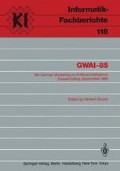Zusammenfassung
Bewegungsanalyse ist ein wichtiger Teilprozeß des Bildverstehens und kann weiter unterteilt werden in [1]:
-
Die Detektion von Bewegung, wie z.B. die Berechnung von Richtung und Betrag der Geschwindigkeiten einzelner Elemente des Bildes.
-
Die Verwendung von Bewegungsmessungen, um z.B. die Bilder in verschiedene Gebiete zu unterteilen oder die 3-dimensionale Struktur der Szene abzuleiten.
Access this chapter
Tax calculation will be finalised at checkout
Purchases are for personal use only
Preview
Unable to display preview. Download preview PDF.
Literaturverzeichnis
Hildreth, Ullman 82: The measurement of visual motion, E. C. Hildreth and S. Ullman, MIT-AI-MEMO No.699, Dezember 1982
Barlow, Levick 65: The mechanisms of directional selective units in rabbit’s retina, H. B. Barlow and W. R. Levick, Journal Physiol., Lond. Vol. 178, pp. 477–504, 1965
Marr, Ullman 81: Directional selectivity and its use in early visual processing, D. Marr and S. Ullman, Proc. R.Soc. Lond. B 211, pp.151–180, 1981
Marr, 82: Vision, D. Marr, W. H. Freeman and Company 1982
Horn, Schunk 81: Determining optical flow, B. K. P. Horn and B. G. Schunk, Artificial Intelligence Vol.17, M.Brady (Hrsg.), pp. 185–203, 1981
Enkelmann 85: Mehrgitterverfahren zur Ermittlung von Verschiebungsvektorfeldern in Bildfolgen, W. Enkelmann, Dissertation am Fachbereich Informatik der Universität Hamburg, Juli 1985
Nagel 83a: Constraints for the estimation of displacement vector fields from image sequences, H.-H. Nagel, Proceedings of International Joint Conference on Artificial Intelligence (IJCAI), Karlsruhe 1983, A. Bundy (Ed.), pp.945–951, 1983
Nagel 83b: On the estimation of dense displacement vector fields from image sequences, H.-H. Nagel, ACM motion: representation and perception, pp. 59–65, 1983
Nagel, Enkelmann 84: Berechnung von Verschiebungsvektorfeldern in Bildbereichen mit linienhafter oder partiell homogener Grauwertverteilung, H.-H. Nagel and W. Enkelmann, Proceeding der Deutschen Arbeitsgemeinschaft Mustererkennung (DAGM) 1984 in Graz, pp. 154–160, Springerverlag 1984
Hildreth 83a: Computing the velocity fields along contours, E. C. Hildreth, ACM motion: representation and perception, pp. 26–32, 1983
Hildreth 83b: The measurement of visual motion, E. C. Hildreth, Ph.D. Thesis, MIT Press, August 1983
Hildreth 84: Computations Underlying the Measurement of Visual Motion, E. C. Hildreth, Artificial Intelligence Vol.23, August 1984
Neumann 82: Knowledge Sources for Understanding and Describing Images Sequences,B. Neumann, Proceedings of German Workshop on Artificial Intelligence (GWAI) 1982, W. Wahlster (Ed.), pp. 1–31, Springerverlag 1982
Gibson 68: What gives rise to the perception of motion?, J. J. Gibson, Psychological Review Vol.75 No.4, pp. 335–346, 1968
Gibson 79: The Ecological Approach to Visual Perception, J. J. Gibson, Houghton Mifflin Company, Boston 1979
Kaplan 69: Kinetic disruption of optical texture: The perception of depth at an edge, G. A. Kaplan, Perception and Psychophysics Vol.6, pp. 193–198, 1969
Dreschler, Haarslev 85: Konzeption für ein Bildverarbeitungssystem zur Lösung des Korrespondenzproblems bei Stereo-Bildfolgen im Rahmen einer komfortablen ADA-Programmierumgebung, L. S. Dreschler-Fischer and V. Haarslev, Robotersysteme 1, pp.29–34, Springerverlag 1985
Mohnhaupt 85: Algorithmische Modelle für primäre Bewegungsanalyse vor dem Hintergrund des menschlichen visuellen Systems, M. Mohnhaupt, Diplomarbeit am Fachbereich Informatik der Universität Hamburg, März 1985
Tsotsos 84: The scope of motion research: from image changes to semantic abstractions, J. K. Tsotsos, Computer Graphics, pp. 7–11, Januar 1984
Author information
Authors and Affiliations
Editor information
Editors and Affiliations
Rights and permissions
Copyright information
© 1986 Springer-Verlag Berlin Heidelberg
About this paper
Cite this paper
Mohnhaupt, M. (1986). ‘No-Match’ Punkte: Informationsquelle für die Detektion von Bewegung. In: Stoyan, H. (eds) GWAI-85. Informatik-Fachberichte, vol 118. Springer, Berlin, Heidelberg. https://doi.org/10.1007/978-3-642-71145-9_30
Download citation
DOI: https://doi.org/10.1007/978-3-642-71145-9_30
Publisher Name: Springer, Berlin, Heidelberg
Print ISBN: 978-3-540-16451-7
Online ISBN: 978-3-642-71145-9
eBook Packages: Springer Book Archive

